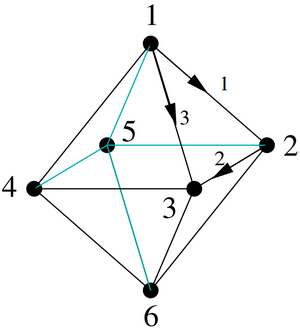Science:Math Exam Resources/Courses/MATH307/April 2012/Question 04 (b)
{{#incat:MER QGQ flag|{{#incat:MER QGH flag|{{#incat:MER QGS flag|}}}}}}
• Q1 (a) • Q1 (b) • Q1 (c) • Q1 (d) • Q2 (a) • Q2 (b) • Q2 (c) • Q3 • Q4 (a) • Q4 (b) • Q4 (c) • Q4 (d) • Q4 (e) • Q5 (a) • Q5 (b) • Q5 (c) • Q6 (a) • Q6 (b) • Q6 (c) • Q6 (d) • Q7 (a) • Q7 (b) • Q7 (c) • Q8 (a) • Q8 (b) • Q8 (c) •
Question 04 (b) |
|---|
|
Consider a network arranged in the shape of an octahedron as in this diagram: The nodes have been labeled with the large numbers and 3 of the edges (resistors) have been given orientations and labeled with small numbers. Assume all resistances are equal to 1. Let D be the incidence matrix (for some choice of labeling and arrows for the remaining edges) and let L be the Laplacian. (b) Write down a non-zero vector in N(DT). |
|
Make sure you understand the problem fully: What is the question asking you to do? Are there specific conditions or constraints that you should take note of? How will you know if your answer is correct from your work only? Can you rephrase the question in your own words in a way that makes sense to you? |
|
If you are stuck, check the hint below. Consider it for a while. Does it give you a new idea on how to approach the problem? If so, try it! |
Hint |
|---|
|
Science:Math Exam Resources/Courses/MATH307/April 2012/Question 04 (b)/Hint 1 |
|
Checking a solution serves two purposes: helping you if, after having used the hint, you still are stuck on the problem; or if you have solved the problem and would like to check your work.
|
Solution |
|---|
|
From part (a) of the question, we determined that so the dimension of is equal to 1, . To find , we can use the rank-nullity theorem which states: Where m is the number of columns in the matrix. Remember that so: So, if we solve for , we get: We can now use to solve for using the rank-nullity again. Finding does not directly give a solution to the question, but it does tell us how many vectors there are in . The rank-nullity theorem states that: where n is the number of rows. Plugging in for what we solved above , we get: This shows that there is only 1 vector in Now solving for what the question asks, lets look at : To find the nullspace of , we have to find vectors such that . Looking at , we can easily see that the only solution to this problem is: This also matches our expectation that there is only 1 vector in N(DT). Proof:
FINAL ANSWER |
{{#incat:MER CT flag||
}}


























